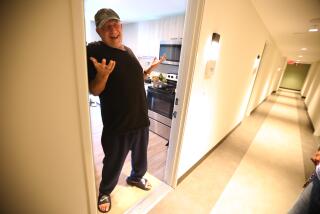Op-Ed: My patient was homeless. I knew she was going to die, but my hands were tied

- Share via
My outreach nurse announced the news after a call from the coroner’s office: There’d been another death on skid row.
“Who now?” I asked.
Her answer was devastating. It was J, whose full name I am not using to protect her privacy.
As a physician practicing on L.A.’s skid row, I’ve seen a lot of deaths among homeless people, but this one broke my heart.
I first met J in July 2014, soon after I started serving patients on skid row. She was standing on the southeast corner of San Julian and 7th streets, leaning against the wall in what looked like a black V-neck shirt, a skirt and Mary Jane shoes with ribbons that tied around her ankles. A big girl, tall and wide, her skin was bronzed from both sun and dirt. Up close, it was clear her shirt was a hospital gown blackened by grime and tucked into her skirt.
In our regular street outreach, J was always willing to talk to us, but she never accepted anything — food, soap, blankets, shelter or medical care.
“Oh, thank you, but no thank you. I’m fine; I’ll be fine,” she’d say.
She was very polite and appreciative of our concern, but always said the same thing in the end. “My family is coming to get me.” At first she said that would happen in 2015, then 2016, then 2017.
The decision to compel treatment in the end comes down to the opinions of emergency responders and medical personnel.
One day, after about six months of visiting her weekly, we had a breakthrough: J allowed me to take her blood pressure. It was alarmingly high at 240/120, a level at which we sometimes hospitalize people. She would accept no treatment, however, even after I told her how dangerous it was, and she never let me take her blood pressure again.
In the summer of 2017, she let us record our conversation on video. After her death, I watched it again in frustration, seeing myself urge her to let me take her blood pressure and warning about the risk of stroke and heart attack. Again and again, she politely but firmly assured me she would be fine. And now she’s dead, at age 58.
Why couldn’t we take care of J?
California law allows forced psychiatric treatment only for those found to be gravely disabled or a “danger to themselves or others.” J certainly wasn’t threatening to others, and she wasn’t at risk of suicide under any traditional definition.
“Grave disability” is defined in California as “a condition in which a person, as a result of a mental disorder is unable to provide for his or her basic personal needs for food, clothing or shelter.” That’s trickier with someone like J. She appeared rational and rooted in reality. She managed to clothe and feed herself. And she had opportunities for shelter that she made a decision to reject.
As a physician, I knew she was at extremely high risk of death because of her medical conditions and the psychiatric issues that kept her from accepting help. But such issues are almost never enough to force treatment.
Even in more clear-cut cases of psychiatric impairment, the decision to compel treatment in the end comes down to the opinions of emergency responders and medical personnel, who have to decide without clear-cut guidelines whether someone meets the standard. Decisions are sometimes influenced by whether a patient is insured, and whether there are available beds, and they can change according to resource availability.
Enter the Fray: First takes on the news of the minute »
One thing that would help is if “grave disability” were interpreted more precisely, with a set of standards that every evaluator would adhere to. We certainly have such standards for other conditions. Paramedics, nurses and doctors all know what to do when someone presents with chest pain. If certain criteria are met, no medical professional would say, “You may be having a heart attack, but we don’t have the room for you.”
At Homeless Health Care Los Angeles, we formed a working group of experts to interpret what grave disability means and create a checklist to help evaluators determine whether someone meets the criteria. The checklist sets out specific questions: Does the individual look malnourished or dehydrated? Does the individual show signs of exposure? Is the individual able to secure adequate and appropriate shelter? With such a checklist in place and accepted, J would have met the legal criteria for grave disability. Her continuing refusal of shelter or housing alone would have been determinative.
The checklist is also aimed at determining whether a person is particularly vulnerable to harm or in danger of imminent death. It has questions about hygiene and serious medical conditions that are being ignored. Here again, J’s refusal of care for her high blood pressure put her at high risk of death. She was a ticking time bomb.
Months before J’s death, when another one of our regulars died, I turned to my nurse and said, “J will be next.”
“Yep,” she agreed without hesitation.
And yet, in the absence of commonly accepted standards for determining grave disability and a shortage of long-term treatment facilities for people with mental illness, we couldn’t get her help.
Susan Partovi is the medical director of Homeless Health Care Los Angeles and co-founder and co-CEO of H.E.A.L. (https://weareheal.com/).
More to Read
A cure for the common opinion
Get thought-provoking perspectives with our weekly newsletter.
You may occasionally receive promotional content from the Los Angeles Times.









